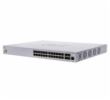KATEGORIE
Zpět k nákupu
Cisco CBS350-24XT Cisco switch CBS350-24XT-EU, 20x10GbE, 4x10GbE RJ45/SFP+
77999 Kč
64462 Kč bez DPH
Dostupnost: Skladem v eshopu 🛈
Part no.: CBS350-24XT-EU
Kód produktu: 22003348
Výrobce: CISCO
Záruka: doživotní
Popis produktu
Řízené switche řady Cisco Business 350 jsou spolehlivými stavebními prvky pro sítě malých firem. Díky intuitivnímu ovládacímu panelu, pokročilým funkcím a všudypřítomnému zabezpečení urychlují spravované switche řady Cisco Business 350 vaši digitální transformaci.
Záruka platná do End of Support 31. 10. 2029.
Oznámení End of Life pro CISCO CBS350
Stránky produktu: CBS350-24XT-EU
Quick start guide: Quick start guide
Switching capacity and forwarding rate (All switches are wire speed and nonblocking) Capacity in Millions of Packets per Second (mpps) (64-byte packets) 240
Switching Capacity in Gigabits per Second (Gbps) 480
Layer 2 switching Spanning Tree Protocol (STP) Standard 802.1d Spanning Tree support
Fast convergence using 802.1w (Rapid Spanning Tree [RSTP]), enabled by default
Multiple Spanning Tree instances using 802.1s (MSTP); 8 instances are supported
Per-VLAN Spanning Tree Plus (PVST+) and Rapid PVST+ (RPVST+); 126 instances are supported
Port grouping/link aggregation Support for IEEE 802.3ad Link Aggregation Control Protocol (LACP)
Up to 8 groups
Up to 8 ports per group with 16 candidate ports for each (dynamic) 802.3ad link aggregation
VLAN Support for up to 4,094 VLANs simultaneously
Port-based and 802.1Q tag-based VLANs; MAC-based VLAN; protocol-based VLAN; IP subnet-based VLAN
Management VLAN
Private VLAN with promiscuous, isolated, and community port
Private VLAN Edge (PVE), also known as protected ports, with multiple uplinks
Guest VLAN, unauthenticated VLAN
Dynamic VLAN assignment via RADIUS server along with 802.1x client authentication
CPE VLAN
Voice VLAN Voice traffic is automatically assigned to a voice-specific VLAN and treated with appropriate levels of QoS. Voice Services Discovery Protocol (VSDP) delivers network wide zero-touch deployment of voice endpoints and call control devices
Multicast TV VLAN Multicast TV VLAN allows the single multicast VLAN to be shared in the network while subscribers remain in separate VLANs. This feature is also known as Multicast VLAN Registration (MVR)
VLAN Translation Support for VLAN One-to-One Mapping. In VLAN One-to-One Mapping, on an edge interface customer VLANs (C-VLANs) are mapped to service provider VLANs (S-VLANs) and the original C-VLAN tags are replaced by the specified S-VLAN
Q-in-Q VLANs transparently cross a service provider network while isolating traffic among customers
Selective Q-in-Q Selective Q-in-Q is an enhancement to the basic Q-in-Q feature and provides, per edge interface, multiple mappings of different C-VLANs to separate S-VLANs
Selective Q-in-Q also allows configuring of Ethertype (Tag Protocol Identifier [TPID]) of the S-VLAN tag
Layer 2 protocol tunneling over Q-in-Q is also supported
Generic VLAN Registration Protocol (GVRP)/Generic Attribute Registration Protocol (GARP) Generic VLAN Registration Protocol (GVRP) and Generic Attribute Registration Protocol (GARP) enable automatic propagation and configuration of VLANs in a bridged domain
Unidirectional Link Detection (UDLD) UDLD monitors physical connection to detect unidirectional links caused by incorrect wiring or cable/port faults to prevent forwarding loops and black holing of traffic in switched networks
Dynamic Host Configuration Protocol (DHCP) Relay at Layer 2 Relay of DHCP traffic to DHCP server in different VLAN; works with DHCP Option 82
Internet Group Management Protocol (IGMP) versions 1, 2, and 3 snooping IGMP limits bandwidth-intensive multicast traffic to only the requesters; supports 2K multicast groups (source-specific multicasting is also supported)
IGMP Querier IGMP querier is used to support a Layer 2 multicast domain of snooping switches in the absence of a multicast router
IGMP proxy The IGMP proxy provides a mechanism for multicast forwarding based on IGMP membership information without the need for more complicated multicast routing protocols.
Head-of-Line (HOL) blocking HOL blocking prevention
Loopback Detection Loopback detection provides protection against loops by transmitting loop protocol packets out of ports on which loop protection has been enabled. It operates independently of STP
Layer 3 IPv4 routing Wirespeed routing of IPv4 packets
Up to 990 static routes and up to 128 IP interfaces
IPv6 routing Wirespeed routing of IPv6 packets
Layer 3 Interface Configuration of Layer 3 interface on physical port, Link Aggregation (LAG), VLAN interface, or loopback interface
Classless Interdomain Routing (CIDR) Support for classless interdomain routing
RIP v2 Support for Routing Information Protocol version 2 for dynamic routing
Policy-Based Routing (PBR) Flexible routing control to direct packets to different next hop based on IPv4 or IPv6 Access Control List (ACL)
DHCP Server Switch functions as an IPv4 DHCP server serving IP addresses for multiple DHCP pools/scopes
Support for DHCP options
DHCP relay at Layer 3 Relay of DHCP traffic across IP domains
User Datagram Protocol (UDP) relay Relay of broadcast information across Layer 3 domains for application discovery or relaying of Bootstrap Protocol (BOOTP)/DHCP packets
Stacking Hardware stacking Up to 4 units in a stack. Up to 200 ports managed as a single system with hardware failover
High availability Fast stack failover delivers minimal traffic loss. Support link aggregation across multiple units in a stack
Plug-and-play stacking configuration/management Active/standby for resilient stack control
Autonumbering
Hot swap of units in stack
Ring and chain stacking options, auto stacking port speed, flexible stacking port options
High-speed stack interconnects Cost-effective high-speed 10G fiber interfaces.
Security ecure Shell (SSH) Protocol SSH is a secure replacement for Telnet traffic. Secure Copy Protocol (SCP) also uses SSH. SSH v1 and v2 are supported
Secure Sockets Layer (SSL) SSL support: Encrypts all HTTPS traffic, allowing highly secure access to the browser-based management GUI in the switch
IEEE 802.1X (Authenticator role) 802.1X: Remote Authentication Dial-In User Service (RADIUS) authentication and accounting, MD5 hash; guest VLAN; unauthenticated VLAN, single/multiple host mode and single/multiple sessions
Supports time-based 802.1X; dynamic VLAN assignment; MAC authentication
IEEE 802.1X supplicant A switch can be configured to act as a supplicant to another switch. This enables extended secure access in areas outside the wiring closet (such as conference rooms)
Web-based authentication Web-based authentication provides network admission control through web browser to any host devices and operating systems
STP Bridge Protocol Data Unit (BPDU) Guard A security mechanism to protect the network from invalid configurations. A port enabled for BPDU Guard is shut down if a BPDU message is received on that port. This avoids accidental topology loops
STP Root Guard This prevents edge devices not in the network administrator’s control from becoming Spanning Tree Protocol root nodes
STP loopback guard Provides additional protection against Layer 2 forwarding loops (STP loops)
DHCP snooping Filters out DHCP messages with unregistered IP addresses and/or from unexpected or untrusted interfaces. This prevents rogue devices from behaving as DHCP Servers.
IP Source Guard (IPSG) When IP Source Guard is enabled at a port, the switch filters out IP packets received from the port if the source IP addresses of the packets have not been statically configured or dynamically learned from DHCP snooping. This prevents IP address spoofing.
Dynamic ARP Inspection (DAI) The switch discards ARP packets from a port if there are no static or dynamic IP/MAC bindings or if there
Popis produktu
Cisco switch CBS350-24XT-EUŘízené switche řady Cisco Business 350 jsou spolehlivými stavebními prvky pro sítě malých firem. Díky intuitivnímu ovládacímu panelu, pokročilým funkcím a všudypřítomnému zabezpečení urychlují spravované switche řady Cisco Business 350 vaši digitální transformaci.
Záruka platná do End of Support 31. 10. 2029.
Oznámení End of Life pro CISCO CBS350
Stránky produktu: CBS350-24XT-EU
Quick start guide: Quick start guide
Switching capacity and forwarding rate (All switches are wire speed and nonblocking) Capacity in Millions of Packets per Second (mpps) (64-byte packets) 240
Switching Capacity in Gigabits per Second (Gbps) 480
Layer 2 switching Spanning Tree Protocol (STP) Standard 802.1d Spanning Tree support
Fast convergence using 802.1w (Rapid Spanning Tree [RSTP]), enabled by default
Multiple Spanning Tree instances using 802.1s (MSTP); 8 instances are supported
Per-VLAN Spanning Tree Plus (PVST+) and Rapid PVST+ (RPVST+); 126 instances are supported
Port grouping/link aggregation Support for IEEE 802.3ad Link Aggregation Control Protocol (LACP)
Up to 8 groups
Up to 8 ports per group with 16 candidate ports for each (dynamic) 802.3ad link aggregation
VLAN Support for up to 4,094 VLANs simultaneously
Port-based and 802.1Q tag-based VLANs; MAC-based VLAN; protocol-based VLAN; IP subnet-based VLAN
Management VLAN
Private VLAN with promiscuous, isolated, and community port
Private VLAN Edge (PVE), also known as protected ports, with multiple uplinks
Guest VLAN, unauthenticated VLAN
Dynamic VLAN assignment via RADIUS server along with 802.1x client authentication
CPE VLAN
Voice VLAN Voice traffic is automatically assigned to a voice-specific VLAN and treated with appropriate levels of QoS. Voice Services Discovery Protocol (VSDP) delivers network wide zero-touch deployment of voice endpoints and call control devices
Multicast TV VLAN Multicast TV VLAN allows the single multicast VLAN to be shared in the network while subscribers remain in separate VLANs. This feature is also known as Multicast VLAN Registration (MVR)
VLAN Translation Support for VLAN One-to-One Mapping. In VLAN One-to-One Mapping, on an edge interface customer VLANs (C-VLANs) are mapped to service provider VLANs (S-VLANs) and the original C-VLAN tags are replaced by the specified S-VLAN
Q-in-Q VLANs transparently cross a service provider network while isolating traffic among customers
Selective Q-in-Q Selective Q-in-Q is an enhancement to the basic Q-in-Q feature and provides, per edge interface, multiple mappings of different C-VLANs to separate S-VLANs
Selective Q-in-Q also allows configuring of Ethertype (Tag Protocol Identifier [TPID]) of the S-VLAN tag
Layer 2 protocol tunneling over Q-in-Q is also supported
Generic VLAN Registration Protocol (GVRP)/Generic Attribute Registration Protocol (GARP) Generic VLAN Registration Protocol (GVRP) and Generic Attribute Registration Protocol (GARP) enable automatic propagation and configuration of VLANs in a bridged domain
Unidirectional Link Detection (UDLD) UDLD monitors physical connection to detect unidirectional links caused by incorrect wiring or cable/port faults to prevent forwarding loops and black holing of traffic in switched networks
Dynamic Host Configuration Protocol (DHCP) Relay at Layer 2 Relay of DHCP traffic to DHCP server in different VLAN; works with DHCP Option 82
Internet Group Management Protocol (IGMP) versions 1, 2, and 3 snooping IGMP limits bandwidth-intensive multicast traffic to only the requesters; supports 2K multicast groups (source-specific multicasting is also supported)
IGMP Querier IGMP querier is used to support a Layer 2 multicast domain of snooping switches in the absence of a multicast router
IGMP proxy The IGMP proxy provides a mechanism for multicast forwarding based on IGMP membership information without the need for more complicated multicast routing protocols.
Head-of-Line (HOL) blocking HOL blocking prevention
Loopback Detection Loopback detection provides protection against loops by transmitting loop protocol packets out of ports on which loop protection has been enabled. It operates independently of STP
Layer 3 IPv4 routing Wirespeed routing of IPv4 packets
Up to 990 static routes and up to 128 IP interfaces
IPv6 routing Wirespeed routing of IPv6 packets
Layer 3 Interface Configuration of Layer 3 interface on physical port, Link Aggregation (LAG), VLAN interface, or loopback interface
Classless Interdomain Routing (CIDR) Support for classless interdomain routing
RIP v2 Support for Routing Information Protocol version 2 for dynamic routing
Policy-Based Routing (PBR) Flexible routing control to direct packets to different next hop based on IPv4 or IPv6 Access Control List (ACL)
DHCP Server Switch functions as an IPv4 DHCP server serving IP addresses for multiple DHCP pools/scopes
Support for DHCP options
DHCP relay at Layer 3 Relay of DHCP traffic across IP domains
User Datagram Protocol (UDP) relay Relay of broadcast information across Layer 3 domains for application discovery or relaying of Bootstrap Protocol (BOOTP)/DHCP packets
Stacking Hardware stacking Up to 4 units in a stack. Up to 200 ports managed as a single system with hardware failover
High availability Fast stack failover delivers minimal traffic loss. Support link aggregation across multiple units in a stack
Plug-and-play stacking configuration/management Active/standby for resilient stack control
Autonumbering
Hot swap of units in stack
Ring and chain stacking options, auto stacking port speed, flexible stacking port options
High-speed stack interconnects Cost-effective high-speed 10G fiber interfaces.
Security ecure Shell (SSH) Protocol SSH is a secure replacement for Telnet traffic. Secure Copy Protocol (SCP) also uses SSH. SSH v1 and v2 are supported
Secure Sockets Layer (SSL) SSL support: Encrypts all HTTPS traffic, allowing highly secure access to the browser-based management GUI in the switch
IEEE 802.1X (Authenticator role) 802.1X: Remote Authentication Dial-In User Service (RADIUS) authentication and accounting, MD5 hash; guest VLAN; unauthenticated VLAN, single/multiple host mode and single/multiple sessions
Supports time-based 802.1X; dynamic VLAN assignment; MAC authentication
IEEE 802.1X supplicant A switch can be configured to act as a supplicant to another switch. This enables extended secure access in areas outside the wiring closet (such as conference rooms)
Web-based authentication Web-based authentication provides network admission control through web browser to any host devices and operating systems
STP Bridge Protocol Data Unit (BPDU) Guard A security mechanism to protect the network from invalid configurations. A port enabled for BPDU Guard is shut down if a BPDU message is received on that port. This avoids accidental topology loops
STP Root Guard This prevents edge devices not in the network administrator’s control from becoming Spanning Tree Protocol root nodes
STP loopback guard Provides additional protection against Layer 2 forwarding loops (STP loops)
DHCP snooping Filters out DHCP messages with unregistered IP addresses and/or from unexpected or untrusted interfaces. This prevents rogue devices from behaving as DHCP Servers.
IP Source Guard (IPSG) When IP Source Guard is enabled at a port, the switch filters out IP packets received from the port if the source IP addresses of the packets have not been statically configured or dynamically learned from DHCP snooping. This prevents IP address spoofing.
Dynamic ARP Inspection (DAI) The switch discards ARP packets from a port if there are no static or dynamic IP/MAC bindings or if there
Přes veškerou snahu zajistit co nejpřesnější popis, obrázky a technické parametry produktů nemůžeme zaručit, že uváděná data odpovídají skutečnosti. Řada výrobců si vyhrazuje právo změny některých parametrů či vlastností bez předchozího upozornění. Potřebujete-li ujištění o určitých parametrech produktu nebo v případě pochybností, kontaktujte prosím svého obchodníka. Pozdější reklamace vlastností je zbytečnou komplikací pro obě strany.



















